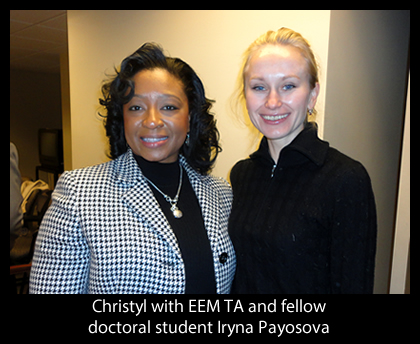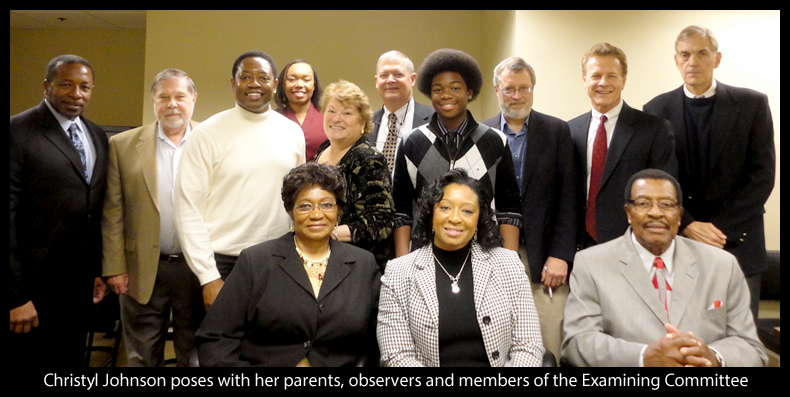During the Spring semester, four students successfully defended their doctoral dissertations on environmental and energy topics. Below is a summary of this important research work
Christyl Johnson
Christyl C. Johnson, Deputy Director for Science and Technology at NASA's Goddard Space Flight Center, defended her dissertation on “Environmental Life Cycle Criteria for Making Decisions about Green versus Toxic Propellant Selections.” Christyl, who formerly was the Executive Director of the National Science and Technology Council at the Office of Science and Technology Policy in the White House, developed a decision aid approach can be used to

perform tradeoff analyses for propellant selection decisions spacecraft applications under the direction of her academic advisor, Professor Michael Duffey. Past studies that explored switching from toxic propellants like AP and hydrazine to green propellants typically focused on economic, performance, and risk characteristics, and did not account for many of the “hidden” costs incurred. Because of this incomplete methodology, the National Aeronautics and Space Administration has never been able to close the business case for committing to large-scale investments in green propellant technologies. Christyl’s research brought these “hidden” costs to light, and provided the space research and development community with decision criteria that will reflect a more accurate account of the costs that must be considered throughout the life cycle. When environmental costs are included in the analysis, scientists can bridge the gap between traditional investment and return on investment models in a timeframe that can be acceptable to investment decision makers.
Serving on Christyl’s Examining Committee were GW Professors Michael Duffey, Gregory Shaw, Lile Murphree, and Jonathan Deason, along with Dr. Woodrow Whitlow (NASA Associate Administrator for Mission Support) and Dr. Michael Ryschkewitsch (NASA Chief Engineer).
Michel Pawlowski
Michel S. Pawlowski defended his dissertation on “Catastrophic Events - Emergency Management Planning Requirements and Success Factors for Catastrophic Response Operations.” Prior to undertaking his doctoral studies at GW, Michel obtained his and undergraduate degree from Indiana University and Master's degrees from Indiana University and the Industrial College of the Armed Forces.

Michel’s research focused on the recognition that existing emergency management response plans, policies, procedures and resources are not fully adequate or appropriate to address a catastrophic event. Catastrophes have impacts and complexities that are orders of magnitude above disasters and community emergencies challenging local, State and Federal communities, organizations and society. They also have the potential to impact the environment and National Security. Therefore, catastrophes have different response operations planning requirements vs. disasters. This places significant challenges on a complex Federal response system operating under the National Response Framework, built upon the National Incident Management System (NIMS) and the Incident Command System (ICS) that provide for standard command and control structures for organizing management of disasters.
Although the national disaster response system within the context of NIMS and ICS successfully manages small scale events, experience has shown it falters when attempting to meet the challenges of large scale, potentially catastrophic events, implying that some key factor or factors are missing. Catastrophes require imagination in their response and different strategies of planning and management, far beyond those of “garden variety” disasters. The Department of Homeland Security has attempted to categorize all-hazard planning on the basis of 15 National Planning Scenarios. Michel’s research project interviewed and surveyed Subject Matter Experts (SMEs) to examine current Complex Catastrophic Disaster Response Planning based upon a comparison of disasters and catastrophes, notice vs. no-notice response operations planning, and identification of Federal success factors which can eventually be applied to develop metrics to gauge success in response to a complex catastrophic disaster. Seventeen (17) Response Success Factors/Themes and their components for a Complex Catastrophic Event were identified.
Serving on Michel’s Examining Committee were Professors Theresa L. Jefferson, John R. Harrald, Michael S. Stankosky, Gregory L. Shaw and Jonathan P. Deason.
Stephen Fortier
Stephen C. Fortier defended his dissertation on “Defining a Best Practices Incident Response Mechanism for Chemical Facilities.” Before undertaking his doctoral program at GW, Stephen received a Bachelor Science degree from West Virginia University, followed by Masters degrees from West Virginia University, George Mason University and the Harvard Business School.

In his research, Stephen investigated the incident response mechanism used by the chemical industry for handling extremely hazardous chemicals. The mechanism was described as the policies, procedures, practices, tools, and methods used to conduct incident response. The chemical industry is responsible for process safety management at all of its facilities, especially those that have off-site consequences in the event of an unplanned release. Initial interviews with industry experts indicated that there was not a formal repeatable method for incident response; and response tended to be ad hoc. Industry experts also wondered if smaller chemical facilities were as successful as large sites in responding to unplanned releases.
Stephen used a concurrent transformative strategy, which is a mixed method approach that involved concurrent qualitative and quantitative research. This method supported the elicitation of opinions from chemical industry experts. The collection of data occurred at 12 chemical facilities located in the United States and Europe. This research analyzed the current practices for emergency response for chemical facilities and provided the specification for a model that could be utilized by small or large chemical facilities.
Business process modeling was used to capture information requirements of participants‘ incident response mechanisms. Stephen documented the technologies, specifically software and information systems, that were utilized to for chemical facility emergency response. Based on the qualitative and quantitative results the researcher defined the best practices characteristics for incident response mechanisms for chemical facilities. The results were captured in a model that can be used as a framework for the chemical industry to utilize when defining an incident response mechanism for a new facility or, to validate an existing response mechanism.
Serving on Stephen’s Examining Committee were GW Professors Gregory L. Shaw, John R. Harrald, Jonathan P. Deason and Joost R. Santos, along with Dr. Carleen F. Maitland, Associate Professor of Information Sciences and Technology at the Pennsylvania State University.
Stephen Fields
Stephen Fields defended his dissertation on “A Quantitative Evaluation for Comparing Technologies for the Remediation of Leaking Underground Storage Tanks.”
Before entering into the doctoral program at GW, Stephen earned a Bachelor of Science degree from the Virginia Polytechnic Institute and State University, and Master of Engineering from the University of Virginia.
In his research, Stephen investigated petroleum releases from Underground Storage Tanks (USTs) and associated piping that represents a major environmental threat to the nation’s soil and groundwater. Leaking underground storage tanks (LUSTs) historically have been the nation's primary source of groundwater contamination. The U.S. Environmental Protection Agency’s federal UST regulations require that contaminated underground storage tank sites be remediated by state environmental agencies to restore and protect groundwater resources and create a safe environment for those that live or work around these sites. Nationally, there is a need to address at least 80,000 groundwater petroleum releases on private property, public property (state and local government property), tribal lands, and federal facilities.
Releases from tanks can cause well water contamination plus toxic vapors that affect human health. The releases also can result in fires and explosions. This research focused on the development of a quantitative evaluation for state program managers to use when managing LUSTs. The objective of this research was to develop a decision-aiding mechanism to assist State program managers in evaluating Air Sparging and Bioremediation remedial technologies in cleaning up contamination from LUST sites, and assist State program managers in forecasting what level of contamination will be removed when applying these two technologies.
Stephen’s research compared two in-situ groundwater remediation technologies: Air Sparging and Bioremediation. This quantitative evaluation examined data from 274 LUST sites from the state of South Carolina during the period 1997-2004. For the 274 LUST sites, 176 used Air Sparging while 98 used Bioremediation as a mitigation technology. Specifically, the quantitative evaluation allowed the computation of the cleanup levels for each of the two in-situ technologies at the respective LUST sites, and a comparison was made to determine which technology was more effective in removing contaminants from LUST sites. Stephen’s research developed a decision-aiding mechanism to assist state program managers in determining which of the two technologies is best in removing contaminants from LUST sites. The results of this analysis for sample sizes with 30 or more observations indicated that there is no statistically significant difference between the mean cleanup levels of Air Sparging and Bioremediation technologies in removing contaminants from LUST sites.
Serving on Stephen's Examining Committee were Professors E. Lile Murphree, Jr., Michael R. Duffey, Thomas A. Mazzuchi, William E. Roper, and Jonathan P. Deason.


